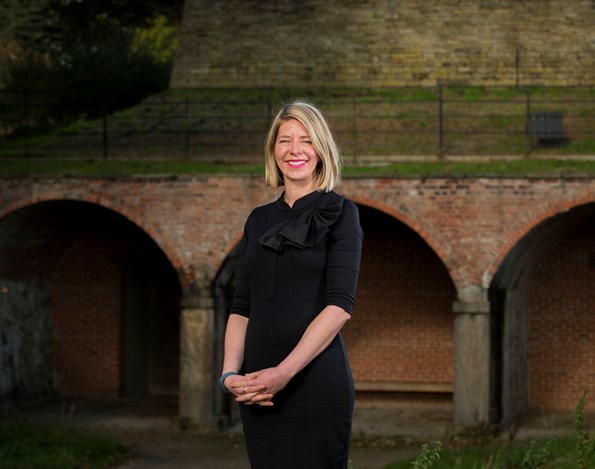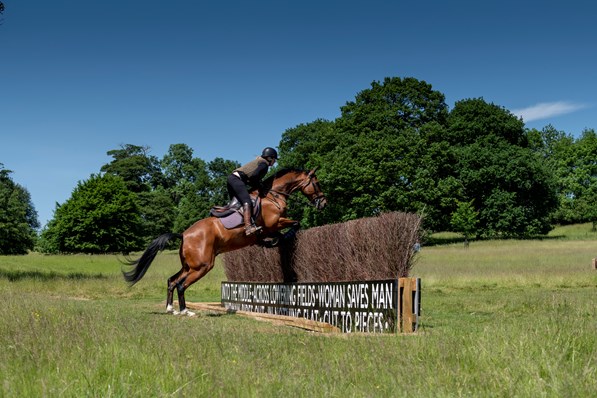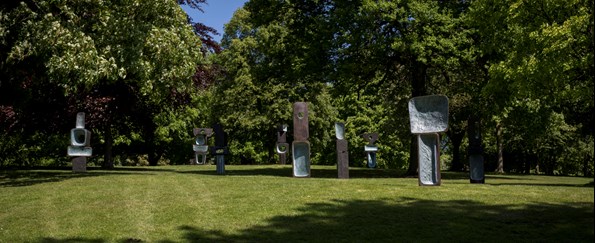
"The relationship between Yorkshire Sculpture Park’s location and identity is absolutely fundamental. The physical landscape we curate and the backdrop of industrial towns and rolling hills determines aesthetic decisions about the location of sculptures as well as providing inspiration for artists to develop new work".
Image: Helen Pheby, photo courtesy to Helen Pheby
Dr Helen Pheby is the Head of Curatorial Programme at Yorkshire Sculpture Park, an international centre for modern and contemporary art set in 500 acres of historic parkland, five galleries, and an 18th-century chapel. Her offsite projects include A Place in Time (2016) at NIROX Sculpture Park in the Unesco Cradle of Humankind, South Africa, and the Kyiv Sculpture Project (2012), the first open-air display of contemporary sculpture in Ukraine. She is also the invited co-curator of the new entrance to Selfridges’ flagship London store.

Helen Pheby, photo credit Jonty Wilde
ArtDependence Magazine talked to Helen about Yorkshire Sculpture Park's mission and ideas, and the role of public art in modern society.
ArtDependence (AD): What is the primary sense of place of Yorkshire Sculpture Park?
Helen Pheby (HP): I hope that it is one of openness. Physically the place is open, with long views, and the space to roam and discover art in a beautiful landscape. Intellectually we aim to programme in an open way as well, to create situations where people will encounter familiar artworks, such as those by Henry Moore and Barbara Hepworth, but also projects by younger artists that might be less expected.
AD: How do you find the idea that landscape architecture is for the people, not just the elite? Who was the Park built for?
HP: YSP is a great example of a space being made accessible to as many people as possible. The landscape we care for was described as wasteland in the Domesday book of 1086, which was a huge survey of most of England commissioned by William the Conqueror. Much of Yorkshire was wasteland at this time because William had violently quashed a rebellion against him. The land was given to one of his faithful knights who established an estate, and there is a wooden house documented as being on site by 1261. The estate increased in size and status, peaking in the 18th century.
The beautiful design of the landscape reflects that for nearly 1000 years it was the pleasure ground of an aristocratic elite, even including huge lakes that were hand-dug by labourers. The estate entered a decline and was sold to the local government in 1948. An arts teacher training college was established in 1949 with a philosophy that art could help to rebuild Europe after the war.

Katrina Palmer 'The Coffin Jump' 2018, a co-commission with 14-18 NOW, photo credit Jonty Wilde
Our Founding Director, Peter Murray CBE, asked if he could curate a sculpture exhibition in 1977, with three main aims: to celebrate the fact that Moore and Hepworth were both born locally; to share the best of international art with a provincial audience; crucially, to open up physical access to a beautiful landscape that had been the preserve of an elite.
We now welcome over half a million visitors each year, including 45,000 young people in education, which is testament to the founding vision.
AD: What is the personality and philosophy of Yorkshire Sculpture Park artspace?
HP: We seek to create a space for people to have extraordinary experiences. In fact I am currently co-supervising a PhD with a local university whose thesis is ‘YSP makes you happy’. So far the results suggest that it does.
AD: What types of sculptures and art elements do you use in your YSP projects?
HP: We curate a rolling programme across eight different outdoor spaces, each with their own character, and in five indoor galleries and an 18th-century chapel. We take an expanded view of sculpture in that it can be any creative encounter in three dimensions. We balance object and experience, established and emerging artists. In the open air we loosely trace a history of sculpture since Rodin, through the modern period of Moore and Hepworth, the new generation of Caro and King to land art and non-object-based practice such as Turrell and Goldsworthy.
Our mission is to be an international centre for the creation, display and appreciation of sculpture and we have an active and vibrant residency programme. This tends to be open-ended, rather than have fixed results in mind, but always leads to brilliant projects and long relationships with artists.

Barbara Hepworth 'The Family of Man' 1970, courtesy the Hepworth Estate, photo credit Jonty Wilde
Our summer 2019 programme is a useful illustration of our approach to sculpture in that we have a major survey of work by David Smith - a show that looks at an important artist in the history of object-based sculpture. In the chapel is an immersive installation by Korean artist Kimsooja, which responds to the particular architecture of the building and encourages people to think about their own bodies in relation to space and light.
Ruth Ewan and Turner-Prize nominee Oscar Murillo have a joint show in Longside that is rooted in the art education heritage of West Yorkshire and YSP, illustrating the vital role of art in society and echoing Beuys’ ideas around social sculpture. In the Weston, people are invited to adopt traditional Indian wrestling moves in an installation designed to encourage consideration of the plight of farmers in India, using their bodies as part of the sculpture.
AD: Tell us about the relationship between park's location and identity and if it reflects the modern 'ecological trend', which is popular among urban landscaping lately?
HP: The relationship between Yorkshire Sculpture Park’s location and identity is absolutely fundamental. The physical landscape we curate and the backdrop of industrial towns and rolling hills determines aesthetic decisions about the location of sculptures as well as providing inspiration for artists to develop new work. For example, we currently have a sound work that responds to GPS locations developed by Dillan Marsh and Eleanor Clare, which people can experience on a walk around the site. Ours is a listed landscape, which means we work with its 18th century design rather than change it to current trends. That said, our programme has always had a strong ecological focus as that is natural in a situation like ours
AD: How did you make it the place where people want to go, spend time with their families, get married?
HP: We have worked really hard over the years, particularly through our learning programme, to make it a space that isn’t intimidating and is comfortable to be in. A large part of this is around hospitality. Making people feel welcome, basic things like staff smiling, that the food offer is good and all the facilities are clean and well cared for. It is also the way that we mediate the art, we invite individual opinions and debate rather than elitist interpretations.
AD: Creating Sculpture Society – what problems are you facing with and what makes you motivated?
HP: One of the main problems just now is around the uncertainty of Brexit. This is practical, in the sense of transport of artworks and border control, but very much psychological as well. The vote has proved to be divisive in the country, highlighting significant inequalities in our society. We have programmes to support people in difficult situations, such as living in poverty or with mental health problems, as well as trying to create a space where everyone is welcome. Crucially, not everyone has to agree either, about the art or wider debates. It’s just so important that we keep talking.
AD: What is the impact of YSP on image of the city?
HP: YSP is described by Wakefield Council as a jewel. This summer we launch the Yorkshire Sculpture International with local partners The Hepworth Wakefield, the Henry Moore Institute and Leeds Art Gallery. This is with a view to celebrate the significant sculpture heritage of the cities and county and to support the true image of the place as important in contemporary art.
AD: How do you cooperate with the UK government and city municipality? What is their supporting impact and financial share in Yorkshire Park Project?
HP: We benefit from financial support from both the local Wakefield government, and from national government through the Arts Council of England, though still raise about 75% of our own income whilst maintaining free admission. As part of these relationships we work on local and national initiatives, such as ensuring the diversity of artists represented in the programme.
AD: Tell us about Yorkshire Graduate Award? Goals, professional impact, realized projects?
HP: We initiated the graduate awards to formalise a strand of our programme that supports artists straight out of university. We recognised that this is a very vulnerable time in an artist’s career, when they lose studio space, technical support and critical review, as well as a network of peers. Our award aims to help with the transition from student to artist and includes support on the ‘business’ of being an artist, such as properly documenting all work and building a catalogue raisonne, how to communicate about their work, how to fundraise.

Ai Weiwei 'Iron Tree' 2013, Private Collection, photo credit Jonty Wilde
We began the Yorkshire Graduate Award last year especially for artists in the region. Connor Shields was the first recipient and made new work using the Caro gift, a bequest of materials left by Sir Anthony Caro for young artists. Connor returned for an open studio over easter 2019 and developed and delivered a workshop with our Learning team. All the artists acknowledge what a huge difference the award has made in terms of their practice and profile, but also confidence and professionalism,
AD: Is there any methodology of locating visual art objects in public domain?
HP: There can be many different approaches. All have to take into consideration fundamental requirements such as Health and Safety. Otherwise there should be an element of joy in working with artists and communities in such a way that the result is really meaningful and resonates with the place and people. For example, a YSP project realm project was Cratehouse for Castleford (2006-9) by the German artists Winter/Hörbelt was inspired by the shipping containers that the residents used as meeting places. It also had a pavilion made of yellow bottle crates, which created a lovely light-filled space. It was only due to be installed for six months, but the people loved it so much they asked for it to stay as long as possible. It enabled the community to get funding for an artist officer for the town, which led to a gallery space as well.
AD: How do you select artists for your projects?
HP: I have an ever-growing list of artists whose work I would love to share with our visitors. When it comes to formalising the programme we work to maintain a balance across different cultures and a diversity of ideas and practice, as well as being mindful of the quality of our different spaces. For example, we need to be respectful of the fact that the graveyard around our chapel is still visited and the space itself is one of calm.
AD: Speaking about public art, what is the role of aesthetic form in society?
HP: I believe really strongly that creativity is essential as counterpoint to the human capacity for destruction and cruelty that we witness on news reports. Experiencing art feeds our sense of wonder and possibility.

ArtDependence Magazine is an international magazine covering all spheres of contemporary art, as well as modern and classical art.
ArtDependence features the latest art news, highlighting interviews with today’s most influential artists, galleries, curators, collectors, fair directors and individuals at the axis of the arts.
The magazine also covers series of articles and reviews on critical art events, new publications and other foremost happenings in the art world.
If you would like to submit events or editorial content to ArtDependence Magazine, please feel free to reach the magazine via the contact page.